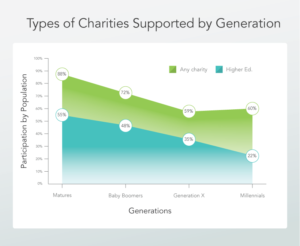In the past year, Eduventures has conducted surveys of alumni from hundreds of institutions. We’ve reported on each of these surveys as they’ve been released. Looking across these studies, we see a clear picture of what needs to be done to deploy a successful advancement strategy given current conditions.
First, let’s look at the current state of broad-based giving according to our survey data. We all know that participation in annual giving is declining with each graduating class. For years, we’ve chalked this up to the impact of millennials, young alumni who are simply less philanthropic than previous generations and who are graduating in greater numbers than any class that went before them. This explanation makes sense if we only look at millennials’ philanthropy to their alma maters.
If we take a more holistic view of millennial philanthropy, however, a different story emerges. When total philanthropy is taken into consideration, we learn that millennials are actually not less philanthropic than their predecessors. They are equally or marginally more philanthropic than the generation before them. The truth is that this generation is in fact highly philanthropic—it is simply not directing its philanthropy toward higher education.
 Engaging alumni is an increasingly difficult challenge, and traditional development strategies aren’t working. To state the obvious, if you have an alumnus who is disengaged or averse to giving for a particular reason, simply asking him or her for a donation—whether in a letter, via email, with a phone call, or face-to-face—won’t yield positive results. We’ve also learned that traditional engagement strategies (reunions) are less effective than in the past.
So what does work? The data is clear. Your strategy needs to focus on outcomes and on specific, cause-based needs
Engaging alumni is an increasingly difficult challenge, and traditional development strategies aren’t working. To state the obvious, if you have an alumnus who is disengaged or averse to giving for a particular reason, simply asking him or her for a donation—whether in a letter, via email, with a phone call, or face-to-face—won’t yield positive results. We’ve also learned that traditional engagement strategies (reunions) are less effective than in the past.
So what does work? The data is clear. Your strategy needs to focus on outcomes and on specific, cause-based needs
 Engaging alumni is an increasingly difficult challenge, and traditional development strategies aren’t working. To state the obvious, if you have an alumnus who is disengaged or averse to giving for a particular reason, simply asking him or her for a donation—whether in a letter, via email, with a phone call, or face-to-face—won’t yield positive results. We’ve also learned that traditional engagement strategies (reunions) are less effective than in the past.
So what does work? The data is clear. Your strategy needs to focus on outcomes and on specific, cause-based needs
Engaging alumni is an increasingly difficult challenge, and traditional development strategies aren’t working. To state the obvious, if you have an alumnus who is disengaged or averse to giving for a particular reason, simply asking him or her for a donation—whether in a letter, via email, with a phone call, or face-to-face—won’t yield positive results. We’ve also learned that traditional engagement strategies (reunions) are less effective than in the past.
So what does work? The data is clear. Your strategy needs to focus on outcomes and on specific, cause-based needs
Focus on Cause- and Outcomes-Based Strategies
The data also shows that donors have become increasingly more cause-oriented (see Figure 1) and are less likely to give to a general annual fund. Due to this cause-orientation, a shrinking percentage of alumni are giving to their colleges, especially among younger classes. Instead, they are prioritizing other organizations in their giving; 60% of millennials give to other charities, and only 25% give to their alma maters. Comparatively, 72% of baby boomers give to charities, and the vast majority give to their schools. To combat this trend, you need to take a more cause-based approach to all of your fundraising efforts. For example, this could entail developing mini campaigns focused on particular institutional needs and directing alumni toward specific giving targets that they care about. Match alumni to needs that meet their specific interests—general annual appeals will prove to be ineffective. Our surveys also show that alumni want career-focused engagement. There is a widening gap between the engagement opportunities that institutions offer and those that alumni want. From baby boomers to millennials, alumni prefer to participate in career-related programming. Traditional engagement strategies—reunions, homecoming, and campus visits—are less attractive to them. This theme has far-reaching effects for all age groups:- Older alumni who have established careers are likely to engage with their schools if called upon to offer career advice to students and young alumni. They are also likely, if asked, to recruit from their alma mater. This plays to their egos and can help them to re-engage in a positive way. I’ve see this work firsthand at schools. Alumni who feel disengaged will re-engage when called upon to share their success.
- Younger alumni are attracted by career networking events, which continue their relationship with the institution by allowing them to engage with the alumni network for career purposes. This continuity ensures that younger alumni do not disengage and maintain positive feelings. Schools that have high engagement rates almost always have active alumni networks that support career development.
- Current students and recent graduates seek help with effective networking and finding internships or their first jobs. This support will solidify their allegiance to their alma maters.

